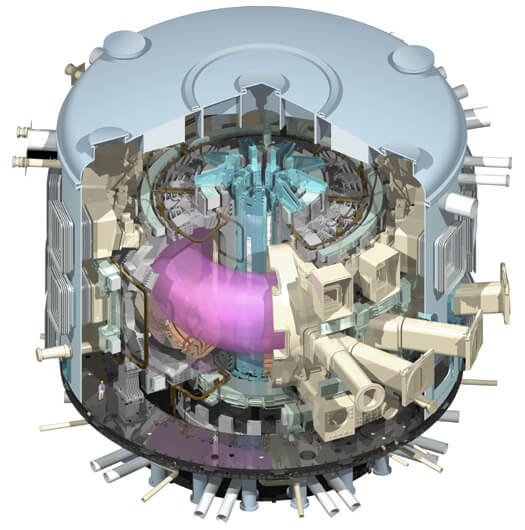Human-engineered
fusion was already demonstrated on a small scale. The problem has
been finding ways of scaling it up to commercial levels in an efficient,
economical, and environmentally benign way.
ITER – previously known as the International Thermonuclear Experimental Reactor
– aims to be the first project to achieve this. Built in southern France
at a cost of €20 billion, it has taken over a decade to construct
and is among the largest scientific projects ever undertaken, second
only to the International Space Station. This joint research experiment
is funded by the US, EU, Japan, Russia, China, India and South Korea.
To demonstrate
net fusion power on a large scale, the reactor must simulate the conditions
at the Sun's core. For this, it uses a magnetic confinement device
called a tokamak. This doughnut-shaped vacuum chamber generates a powerful
magnetic field that prevents heat from touching the reactor's walls.
Tiny quantities of fuel are injected into and trapped within the chamber.
Here they are heated to 100 million degrees, forming a plasma. At such
high temperatures, the light atomic nuclei of hydrogen become fused
together, creating heavier forms of hydrogen such as deuterium and tritium.
This releases neutrons and a huge amount of energy.
Following
its operational activation in 2022,* it
is hoped that ITER will eventually produce over 500 megawatts of
power, in bursts of 400 seconds or more. This compares with 16 MW for
the Joint European Torus (JET) in 1997, the previous world record peak
fusion power, which lasted only a few seconds.
ITER will
require many more years before its reactor has been sufficiently
perfected. To generate the sort of continuous levels of power required
for commercial operation, it will need a way of holding the plasma in
place at the critical densities and temperatures. This will need refinements
in the design of the chamber, such as better superconducting magnets
and advances in vacuum systems.
However,
it could ultimately lead to a revolution in energy. If this project
were to succeed, humanity would gain a virtually unlimited supply of
clean, green electricity.*

No comments :
Post a Comment